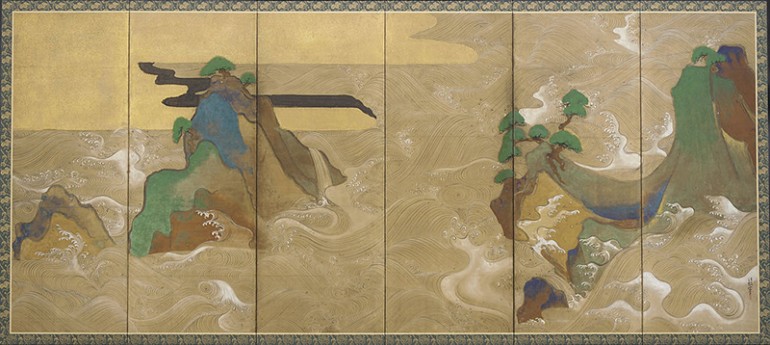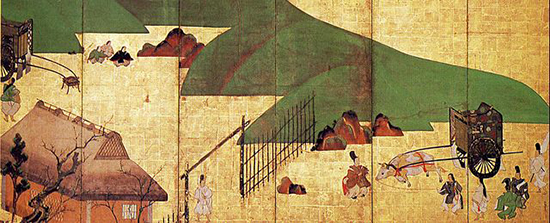It is estimated that Japanese painter Tawaraya Sōtatsu was born sometime in the 16th century. He was the co-founder of the Japanese painting school called Rimpa (Rinpa) art school. He was initially a machi-eshi or town painter.
It was in Kyoto where he started his career as a fan-painter. The courtly culture of Kyoto greatly influenced Sōtatsu. He came to work for the court where he produced calligraphy papers with fine decorations. Later he met one of Japan’s greatest calligraphers and designer, Hon’ami Kōetsu and did the under-designs in silver and gold for the writings of Kōetsu, such as the 17th century “Deer Scroll.” The scroll contained a series of 28 poems. It showcased the confident and firm brushstrokes of Kōetsu’s calligraphy and the fragile and delicate paintings of deer done by Sōtatsu. The original scroll was 20 meters long, but was eventually cut up in 1935 into two pieces. The two collaborated in three other masterpieces, “Scroll of Flowers of Four Seasons,” the “Lotus Scroll” and the “Cranes Scroll.” The former could be viewed at the Hatakeyama Memorial Museum of Fine Art in Tokyo while the latter is at the Kyoto National Museum. The “Lotus Scroll,” which depicted the life story of the lotus flower, was severely damaged during the earthquake in 1923 and had to be cut up and distributed to different collections.
Sōtatsu was popular for his high level of workmanship where the careful placements of fans and decorative screens were needed. He pioneered the tarashikomi technique, which was the process of dropping one color on top of another while the first color was still wet. It was a technique that was difficult to master since wet ink was hard to control. He was also a pioneer in the original style of painting in monochrome, where ink was used like it was colored pigment. One of the best examples of his work in this technique was the illustrated covers of the Lotus Sutra, one of the most influential and most important scriptures of Buddhism. Sōtatsu’s awesome covers were created in 1602, and were replacement frontispieces and covers for some of the Buddhist sutras written in the 12th century. The 33 lavishly decorated scrolls, known as the Heike Sutras were donated by the Heike clan to the Itsukushima Shrine in 1164.
Relatively Unknown
Information about the early life of Tawaraya Sōtatsu was unknown, although he was an artist during the Tokugawa period in Kyoto from 1600-1630. He combined the traditional themes of Yamato-e (indigenous school of narrative scroll paintings in Japan) and the decorative and bold designs of some of the famous screen painters of Japan during the Azuchi-Momoyama period. Sōtatsu pioneered many painting techniques during his time, such as defining the forms and shapes with color instead of ink outlines, as well as the wet-on-wet technique, which involved applying multiple layers of ink or paint on the first layer while it is still wet. He greatly influenced many artists you came after him, particularly Ogata Kōrin, who was specifically influenced by Sōtatsu’s treatment of space and his use of color, particularly silver and gold.
His date of birth and death were not known and some of the established facts related to his life said that he came from an affluent merchant’s family. It was also known that he received the rank of hokkyō, an honorary title bestowed on artists of high distinction. The reason why he was almost relatively unknown was because he did not belong to any of the recognized schools of painting, such as Tosa, Hasegawa or Kanō. He was also not from the warrior (samurai) class or the nobility, the classes that usually provided outstanding painters during those times.
Conjectures
From the few dated works of Sōtatsu that were available, it was believed that his year of birth was around 1570. He started to become a prominent artist early in the 17th century. There was speculation that he was associated with the Tawaraya weaving factory in Kyōto. From a novel and a diary that referred to the Tawaraya fans and Tawaraya pictures, there were suggestions that the pictorial images were highly popular.
Although no one knows who his teachers were, his style showed that it came from the decorative and colorful traditional Japanese painting instead of the Chinese style of ink painting called sumi-e, working in color and in monochrome.
Many of his works were not dated so chronology was difficult to establish, but it was known that a group of paintings he did for the sliding doors of Kyōto’s Yōgen Temple indicated that he was already famous then.
Photo Attribution:
Featured and 1st image by Tawaraya Sōtatsu [Public domain], <a href=”https://commons.wikimedia.org/wiki/File%3ATawaraya_Sotatsu_-_Waves_at_Matsushima_-_Google_Art_Project.jpg”>via Wikimedia Commons</a>
2nd image by Tawaraya Sotatsu died in 1643 (scanned from a book) [Public domain, Public domain or Public domain], <a href=”https://commons.wikimedia.org/wiki/File%3ATawaraya-Genji-Sekiya-zu-R.jpg”>via Wikimedia Commons</a>

